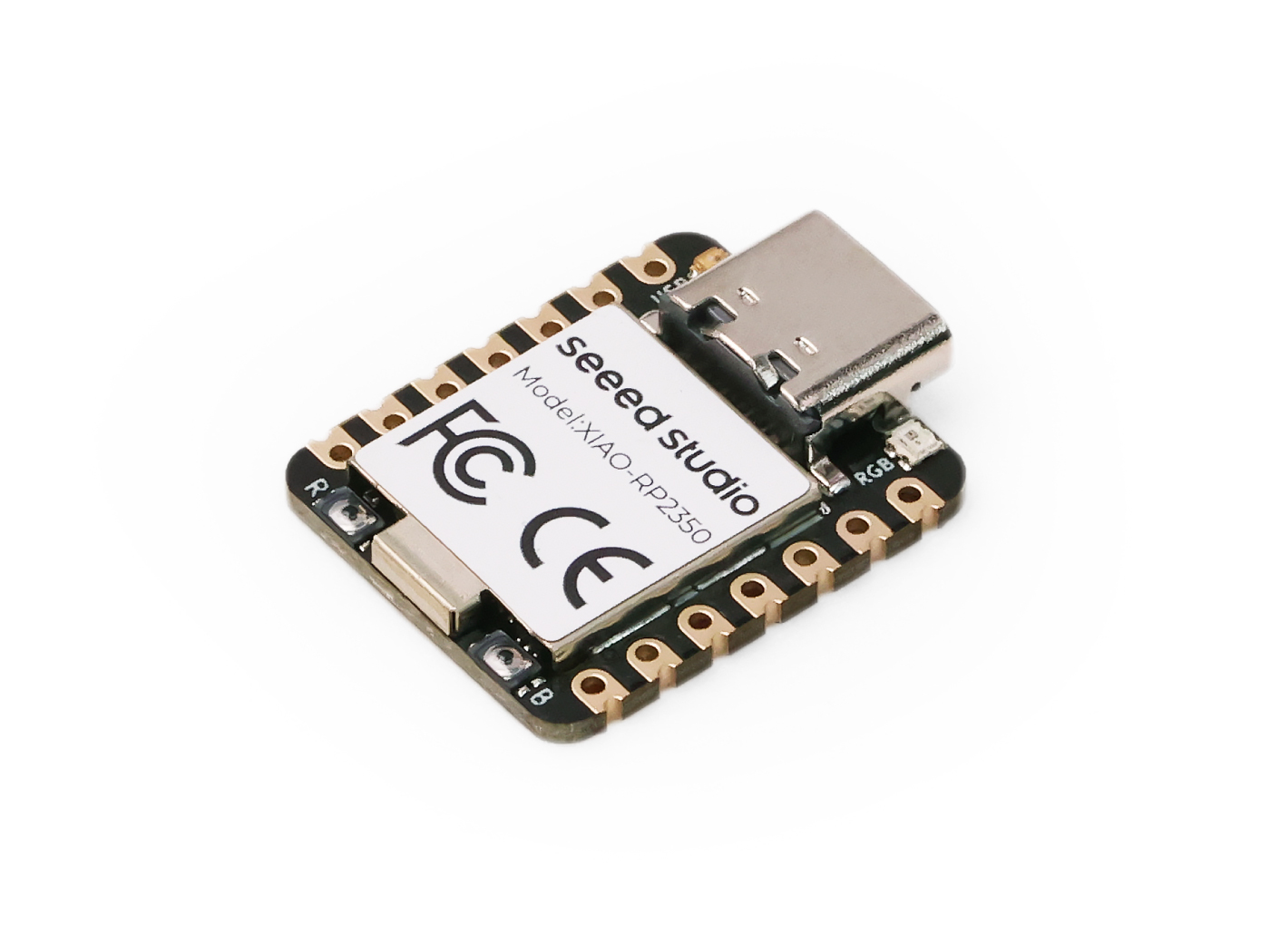Seeed Studio XIAO RP2350
chip:rp2350
The Seeed Studio XIAO RP2350 is a general purpose board supplied by Seeed Studio and it is compatible with the Rapiberry RP2350 ecosystem, sharing the same MCU as Rapiberry Pi Pico 2.

Features
- Raspberry Pi RP2350, ARM® Dual Cortex-M33 @ 150MHz, FPU
- 520kB SRAM, 2MB Flash
- Security: OTP, Secure Boot, Arm TrustZone
- USB Type-C interface
- 19 Pins:3x Analog,19x Digital, 2x I²C, 2x UART, 2x SPI, All PWM
- 1 user LED, 1 power LED,1 RGB LED (WS2812)
- 1 RESET button, 1 BOOT button
Serial Console
By default, a serial console appears on pins 6 (TX GPIO) and pin 7 (RX GPIO). This console runs a 115200-8N1. The board can be configured to use the USB connection as the serial console.
User LED
The USER LED, the yellow LED on the XIAO RP2350, is connected to GPIO25/D19 according to the schematic diagram. The USER LED will light up when set to a low level and turn off when set to a high level.
Buttons
The RESET and BOOT buttons can be used to enter bootloader mode by press and hold BOOT buttons and then press and release RESET button. Then, the board will enumerate as a storage device to a computer connected via USB. Saving a .UF2 file to this device will replace the Flash ROM contents on the RP2350.
Pin Mapping
Pads numbered anticlockwise from USB connector.
Pad Signal Notes
0 GPIO26 D0/A0 1 GPIO27 D1/A1 2 GPIO28 D2/A2 3 GPIO5 D3/A3 4 GPIO6 D4/SDA 5 GPIO7 D5/SCL 6 GPIO0 D6/Default TX for UART0 serial console 7 GPIO1 D7/Default RX for UART0 serial console 8 GPIO2 D8/SCK 9 GPIO4 D9/MISO 10 GPIO3 D10/MOSI 11 12 3V3 Ground Power output to peripherals 13 VIN +5V Supply to board
Power Supply
The working voltage of the MCU is 3.3V. Voltage input connected to general I/O pins may cause chip damage if it's higher than 3.3V.
Installation
- Configure and build NuttX:
git clone https://github.com/apache/nuttx.git nuttx
git clone https://github.com/apache/nuttx-apps.git apps
cd nuttx
make distclean
./tools/configure.sh xiao-rp2350:nsh
make V=12. Connect the Seeed Studio XIAO RP2350, and enter bootloader mode, once the board is detected as a USB Mass Storage Device, copy "nuttx.uf2" into the device.
- To access the console, TX and RX pins must be connected to the device such as USB-serial converter.
Configurations
nsh
Basic NuttShell configuration (console enabled in UART0, at 115200 bps).
usbnsh
Basic NuttShell configuration using CDC/ACM serial (console enabled in USB Port, at 115200 bps).
combo
This configuration enabled NuttShell via Serial and enabled led, gpio and ws2812 examples:
Testing leds:
nsh> leds
leds_main: Starting the led_daemon
leds_main: led_daemon started
led_daemon (pid# 3): Running
led_daemon: Opening /dev/userleds
led_daemon: Supported LEDs 0x01
led_daemon: LED set 0x01
nsh> led_daemon: LED set 0x00
led_daemon: LED set 0x01
led_daemon: LED set 0x00
led_daemon: LED set 0x01
led_daemon: LED set 0x00Testing gpios:
PIN/GPIO Mode Device
D0/P0.02 Input /dev/gpio0 D2/P0.28 Output /dev/gpio1 D1/P0.03 Input /dev/gpio2
nsh> gpio -w 1 /dev/gpio26
Driver: /dev/gpio26
Interrupt pin: Value=0
Verify: Value=0
nsh> gpio /dev/gpio27
Driver: /dev/gpio27
Input pin: Value=0
nsh> gpio /dev/gpio27
Driver: /dev/gpio27
Input pin: Value=1
nsh> gpio -o 1 /dev/gpio28
Driver: /dev/gpio28
Output pin: Value=0
Writing: Value=1
Verify: Value=1
nsh> gpio -o 0 /dev/gpio28
Driver: /dev/gpio28
Output pin: Value=1
Writing: Value=0
Verify: Value=0Testing ws2812:
nsh> ws2812